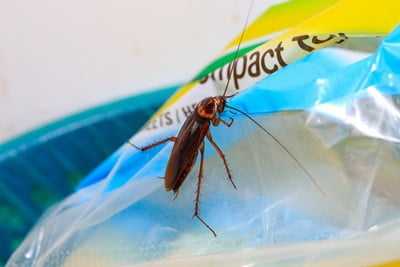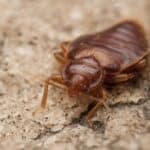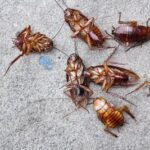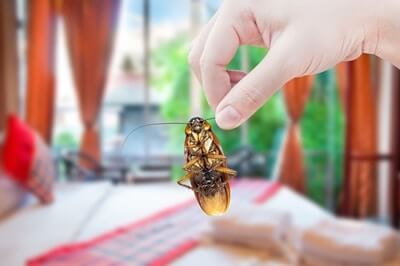Cockroaches can chew through all sorts of plastic, including your plastic grocery bags. This can leave you wondering how safe your kitchen food is. After all, most of us keep leftovers and raw food in ziplocks, Tupperware, and other plastic containers. Roaches have strong jaws with sharp mandibles.
Cockroaches can chew through certain plastics. The thinner plastics, made for single-use tasks, are easy for roaches to gnaw through. This includes plastic grocery bags, garbage bags, bread bags, and ziplock bags. These fragile plastics can tear easily and are no match for a hungry cockroach. The thicker polyethylene blends used to create plastic jars are the best source of cockroach-proof containers.
No matter how strong the cockroach is, it will not be able to chew through thick plastic. Still, cockroaches can get through the smallest gaps. So, always ensure that your lids or bagged items are air-tight and sealed properly, as the smell of food will attract cockroaches. Never eat food that’s been touched by cockroaches.
Can Cockroaches Bite Through Plastic?
Unfortunately, cockroaches can bite through plastic. Its chemical nature is no deterrent to roaches. They will eat just about anything, from feces to decaying food scraps to plastic bags.
Cockroaches have a powerful set of jaws, or mandibles, at their disposal. PLoS notes that, due to insects’ diversity, little is known about the jaw strengths of individual species. However, it is known that cockroaches can apply impressive strength to their bites. It’s enough to chew through many organic and inorganic materials, including plastic.
Plastic comes in many forms, strengths, and densities. Tupperware containers, for example, are much tougher than bread bags. If roaches make it inside, you could find your next meal has been contaminated.
Even frequently sterilized and clean environments can harbor cockroach populations that carry bacteria and germs. This was proven through a Cambridge University case study. The study’s specimens, caught in hospitals, were also contaminated with many antibiotic-resistant bacteria. So, it doesn’t matter if your kitchen is regularly cleaned and bleached as roaches may still be working away at your food containers.
Can Roaches Eat Through Ziplock Bags?
Roaches can eat through ziplock bags. The air-tight seal will only limit the scent of food wafting out. If a roach finds it, the recyclable polypropylene bags will easily tear. Worse still, the airtight seal will only keep food odor contained for a short time. Bags are at more risk if they’re:
- Reused
- Contain food for more than a few days
- Unrefrigerated
The food contents will begin to sink into the plastic. That can be detected through a cockroach’s keen sense of smell. Likewise, ziplocks will retain the smell of food that they’ve held for a long time. That can mean that your garbage can gives off a cockroach-friendly odor. Always seal ziplock bags correctly and only use them for short-term storage.
Can Roaches Eat Through Bread Bags?
Bread bags do little to protect against hungry cockroaches. The plastic is flimsy and does not create an air-tight seal. That leaves a scent trail that roaches will quickly detect.
A bread bag’s flimsy design also has gaps, so it’s easy for people to tear holes in one without realizing it. This causes the bread to go stale sooner, tempting roaches. A cockroach can easily widen this opening to get through.
If the roach has unrestricted access, it will return to the food for as long as it’s available. As it travels between the food and its den, other cockroaches will pick up the scent trail. Before you know it, your kitchen will be riddled with bacteria.
Can Roaches Eat Through Garbage Bags?
With a little too much force, nearly all plastic garbage bags can be torn. Cockroaches can also easily bite through the plastic, especially brands designed to stretch rather than tear. The plastic is malleable rather than thick.
While that design helps us carry heavy loads, a cockroach doesn’t intend to tear through or apply physical force. Instead, their mandibles can easily gnaw through the material.
Due to a garbage bag’s purpose, it will soon attract cockroaches. Once used, it’s full of organic waste and food. This releases a scent, even before the food starts to rot and break down.
Some manufacturers tackle this with perfumes and bacteria-resistant additives. However, cockroaches are resilient against smells, despite their keen senses. Even bleach, a chemical they actively dislike, may be ignored in favor of a reliable, carbohydrate-rich food source.
Keeping cockroaches away from your garbage involves frequently cleaning the cans. This removes any matter that pests, such as roaches, can devour. Likewise, sanitizing the area with bleach will kill germs and bacteria. This will remove the tempting scent and replace it with an odor that cockroaches actively dislike.
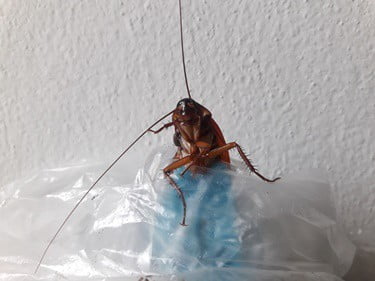
Do Plastic Bags Attract Roaches?
Plastic bags do not attract cockroaches, but the items stored and carried in them do. As mentioned, even airtight ziplocks can eventually become permeated with food smells. Cockroaches will detect these odors.
As scavengers, roaches exist as living recycling machines. They will smell this temptation and eat whatever they find. In the wild, such animals are essential to the ecosystem. In your home, this clearly isn’t the case.
With cold items, the water from condensation may also attract cockroaches. That’s because plastic does a great job of preventing moisture loss. Even a small puddle of water can remain for days. This is the ideal kind of environment for a cockroach – warm, enclosed, and damp. Always ensure that any plastic bags you keep, for whatever reason, are dry and clean before being stored away.
Do Cockroaches Live In Plastic Bags?
A clear plastic bag isn’t the ideal home for a cockroach. However, other plastic bags, or those shoved into tight spaces, can be attractive, especially if there are food sources nearby.
Cockroaches will not nest or lay their eggs in plastic bags, but they will in paper bags. Paper-based products become a source of food for their young once they have hatched.
Are There Cockroach-Proof Plastics?
As powerful as a cockroach’s jaws are, it can’t chew through thick plastics. So, the best way to store food is inside air-tight Tupperware containers. These have two main advantages:
- It prevents scents from escaping
- Stops curious cockroaches from getting inside
There is an extensive range of Tupperware storage containers available. Some have vents for pouring food and allowing steam to escape. However, these varieties aren’t always air-tight.
This weakness may seem insignificant, but it could be just enough to attract cockroaches. With their sturdy exoskeleton, they can squeeze through the smallest gaps. Young cockroaches will easily be able to get inside. Depending on whether the food has any moisture content, nymphs may never need to leave.
Be careful about the Tupperware that you store your food in. Outside of the fridge, it’s always best to use those with air-tight seals and thick plastic walls.
How Long Can Roaches Live In A Plastic Bag?
Plastic bags pose a risk of suffocation. This material doesn’t breathe like paper, therefore creating an air-tight seal. This can lead some people to wonder: can you suffocate a cockroach in a plastic bag?
While it’s certainly less dangerous than using insecticides, it’s not a smart method. Cockroaches will not suffocate in a plastic bag for the following reasons:
- Cockroaches can survive for several minutes without air.
- Gases can still pass through microscopic holes in the plastic.
So, even if you kept the roach in a plastic bag indefinitely, it would still survive. Given the small amount of oxygen cockroaches need, this suffocation tactic won’t kill them. A plastic bag is not a vacuum of space.
If you keep the cockroach in a plastic bag long enough, it can technically die of dehydration or starvation. However, it’s more likely to chew itself an escape hatch long before that ever occurs.
How Long Can Cockroaches Survive In A Plastic Container?
An air-tight plastic container will prevent cockroaches from escaping. It will take a cockroach a week to die from dehydration, which will kill it before starvation occurs.
Chemical-free methods used for killing cockroaches include:
- Sealing them in a plastic container.
- Placing them in the freezer for a few days.
The plastic container will keep them trapped. After that, the consistently sub-freezing temperatures will kill them.
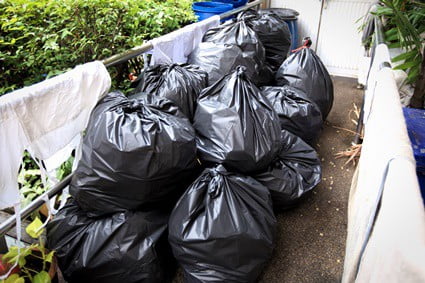
Can Cockroaches Get Inside Plastic Storage Containers?
Outside of storing food, you may use large plastic containers to hold household items. Since attics, garages, basements, and closets are prime hiding spots for cockroaches, you may feel concerned over their safety. Can roaches eat through plastic containers used for home storage?
Plastic storage containers are the most resilient against a roach infestation because the plastic is thick and durable. Unless it’s used to house pet food, it won’t give off enticing food smells.
However, be sure to seal them, as cockroaches are expert climbers. Even smooth, plastic surfaces can be scaled with their dexterous legs. It’s also recommended that you get tubs with locks. This creates a tight seal that can stop most cockroaches from getting inside.
Plastic containers that lack a seal can house cockroaches. Once inside, they will be rarely disturbed, allowing them to nest and flourish.
Can Cockroaches Chew Through Take-Away Containers?
Take-away containers are made from cheap plastic that breaks annoyingly easily. Often designed to be single-use, it is not built for long-term storage. Even still, this plastic is thick enough to prevent cockroaches from chewing through the walls or lid.
However, these containers splinter and crack easily. A determined cockroach may be able to squeeze itself through a small gap and contaminate your food. It’s best not to reuse take-away containers for food storage once they are damaged. They’re OK for storing craft materials, spare nails, or similar items only.
Can Cockroaches Chew Through Plastic Jars?
Plastic jars are made from high-density polyethylene. This sturdy plastic is far too tough for a cockroach to chew through. Even humans experience difficulty cutting up these containers with knives and box cutters. Polyethylene blends are actually used to make plastic enclosures for animals, including:
- Snakes
- Amphibians
- Lizards
- Cockroaches
With that said, improperly sealed lids can enable roaches to get inside. A plastic jar where food has dribbled outside of the container will attract roaches. So, be sure to seal the lid properly and clean up any spills, if necessary.
Will Plastic Kill Cockroaches?
Plastic is an indigestible substance. By gnawing on plastic to get into your food, surely the cockroach will swallow some plastic, thus ending its life eventually. So, will plastic kill a cockroach?
Much depends on the amount of plastic that’s ingested. Tiny amounts of plastic will likely pass through the cockroach’s system. In the unlikely event that the cockroach eats too much plastic, it may die from impaction.
Plastic bags, bread bags, and ziplock bags do little to keep your food safe from roaches. Instead, it would help if you got thick plastic storage containers or Tupperware. These are durable enough to prevent cockroach access.
